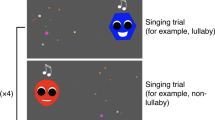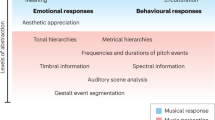Abstract
The study of musical abilities and activities in infancy has the potential to shed light on musical biases or dispositions that are rooted in nature rather than nurture. The available evidence indicates that infants are sensitive to a number of sound features that are fundamental to music across cultures. Their discrimination of pitch and timing differences and their perception of equivalence classes are similar, in many respects, to those of listeners who have had many years of exposure to music. Whether these perceptual skills are unique to human listeners is not known. What is unique is the intense human interest in music, which is evident from the early days of life. Also unique is the importance of music in social contexts. Current ideas about musical timing and interpersonal synchrony are considered here, along with proposals for future research.
This is a preview of subscription content, access via your institution
Access options
Subscribe to this journal
Receive 12 print issues and online access
$209.00 per year
only $17.42 per issue
Buy this article
- Purchase on Springer Link
- Instant access to full article PDF
Prices may be subject to local taxes which are calculated during checkout

Ivelisse Robles
Similar content being viewed by others
References
Hauser, M.D., Chomsky, N. & Fitch, W.T. The faculty of language: what is it, who has it, and how did it evolve? Science 298, 1569–1579 (2002).
Davidson, L. Tonal structures of children's early songs. Mus. Percept. 2, 361–373 (1985).
Rubin, D.C. Memory in Oral Traditions: the Cognitive Psychology of Epics, Ballads and Counting-out Rhymes (Oxford Univ. Press, New York, 1995).
Patel, A. Language, music and the brain. Nat. Neurosci. 6 674–681 (2003).
Besson, M.B. & Schon, D. Comparison between language and music. Ann. NY Acad. Sci. 930, 232–258 (2001).
Hockett, C.F. The problem of universals in language. in Universals of Language 2nd edn. (ed. Greenberg, J.H.) 1–29 (MIT Press, Cambridge, Massachusetts, 1966).
Pinker, S. How the Mind Works (Norton, New York, 1997).
Merriam, A.P. The Anthropology of Music (Northwestern Univ. Press, Evanston, Illinois, 1964).
Sloboda, J.A. & O'Neill, S.A. Emotions in everyday listening to music. in Music and Emotion: Theory and Research (eds. Juslin, P.N. & Sloboda J.A.) 415–429 (Oxford Univ. Press, Oxford, UK, 2001).
Trehub, S.E. & Trainor, L.J. Singing to infants: lullabies and play songs. Adv. Inf. Res. 12, 43–77 (1998).
Benzon, W. Beethoven's Anvil: Music in Mind and Culture (Basic Books, New York, 2001).
Juslin, P.N. Communicating emotion in musical performance. in Music and Emotion: Theory and Research (eds. Juslin, P.N. & Sloboda, J.A.) 309–337 (Oxford Univ. Press, Oxford, UK, 2001).
Scherer, K.R. & Zentner, M.R. Emotional effects of music: Production rules. in Music and Emotion: Theory and Research (eds. Juslin, P.N. & Sloboda, J.A.) 361–392 (Oxford Univ. Press, Oxford, UK, 2001).
Trehub, S.E., Thorpe, L.A. & Morrongiello, B.A. Organizational processes in infants' perception of auditory patterns. Child Dev. 58, 741–749 (1987).
Werner, L.A. Interpreting developmental psychoacoustics. in Developmental Psychoacoustics (eds. Werner, L.A. & Rubel, E.W.) 47–88 (Amer. Psychol. Assoc., Washington, DC, 1992).
Trehub, S.E., Schneider, B.A. & Henderson, J.L. Gap detection in infants, children and adults. J. Acoust. Soc. Am. 98, 2532–2541 (1995).
Trehub, S.E. Human processing predispositions and musical universals. in The Origins of Music (eds. Wallin, N.L., Merker, B. & Brown, S.) 427–448 (MIT Press, Cambridge, Massachusetts, 2000).
Trehub, S.E., Thorpe, L.A. & Trainor, L.J. Infants' perception of good and bad melodies. Psychomusicology 9, 5–19 (1990).
Trainor, L.J. & Trehub, S.E. What mediates infants' and adults' superior processing of the major over the augmented triad? Mus. Percept. 11, 185–196 (1993).
Trehub, S.E., Schellenberg, E.G. & Kamenetsky, S.B. Infants' and adults' perception of scale structure. J. Exp. Psychol. Hum. Percept. Perform. 25, 965–975 (1999).
Schellenberg, E.G. & Trehub, S.E. Natural musical intervals: Evidence from infant listeners. Psychol. Sci. 7, 272–277 (1996).
Trainor, L.J. & Heinmiller, B.M. The development of evaluative responses to music: Infants prefer to listen to consonance over dissonance. Inf. Behav. Dev. 21, 77–88 (1998).
Trainor, L.J., Tsang, C.D. & Cheung, V.H.W. Preference for sensory consonance in 2-and 4-month-old infants. Mus. Percept. 20, 187–194 (2002).
Zentner, M.R. & Kagan, J. Perception of music by infants. Nature 383, 29 (1996).
Trehub, S.E. Musical predispositions in infancy. Ann. NY Acad. Sci. 930, 1–16 (2001).
Sachs, C. The Rise of Music in the Ancient World: East and West (Norton, New York, 1943).
Hauser, M.D. & McDermott, J. The evolution of the music faculty: comparative perspectives. Nat. Neurosci. 6, 663–668 (2003).
Jusczyk, P.W. The Discovery of Spoken Language (MIT Press, Cambridge, Massachusetts, 1997).
Saffran, J.R. Absolute pitch in infancy and adulthood: the role of tonal structure. Dev. Sci. 6, 35–43 (2003).
Saffran, J.R., Loman, M.M. & Robertson, R.R.W. Infant memory for musical experiences. Cognition 77, B15–B23 (2000).
Krumhansl, C.L. & Keil, F.C. Acquisition of the hierarchy of tonal functions in music. Mem. Cognit. 10, 243–251 (1982).
Trainor, L.J. & Trehub, S.E. Key membership and implied harmony in Western tonal music: developmental perspectives. Percept. Psychophys. 56, 125–132 (1994).
Smith, J.D., Kemler-Nelson, D.G., Grohskopf, L.A. & Appleton, T. What child is this? What interval was that? Familiar tunes and music perception in novice listeners. Cognition 52, 23–54 (1994).
Werker, J.F. & Tees, R.C. Influences on infant speech processing. Annu. Rev. Psychol. 50, 509–535 (1999).
Trainor, L.J. & Trehub, S.E. A comparison of infants' and adults' sensitivity to Western musical structure. J. Exp. Psychol. Hum. Percept. Perform. 18, 394–402 (1992).
Lynch, M.P., Eilers, R.E., Oller, D.K. & Urbano, R.C. Innateness, experience and music perception. Psychol. Sci. 1, 272–276 (1990).
Burns, E.M. Intervals, scales, and tuning. in The Psychology of Music 2nd edn. (ed. Deutsch, D.) 215–264 (Academic Press, San Diego, 1999).
Mâche, F.-B. The necessity of and problems with a universal musicology. in The Origins of Music (eds. Wallin, N.L., Merker, B. & Brown, S.) 473–479 (MIT Press, Cambridge, Massachusetts, 2000).
Nettl, B. An ethnomusicologist contemplates universals in musical sound and musical culture. in The Origins of Music (eds. Wallin, N.L., Merker, B. & Brown, S.) 463–472 (MIT Press, Cambridge, Massachusetts, 2000).
Hulse, S.H. & Cynx, J. Relative pitch perception is constrained by absolute pitch in songbirds (Mimus Molothrus and Sturnus). J. Comp. Psychol. 99, 176–196 (1985).
Hurly, T.A., Ratcliffe, L., Weary, D.M. & Weisman, R. White-throated sparrows (Zonotrichia albicollis) can perceive pitch change in conspecific song by using the frequency ratio independent of the frequency difference. J. Comp. Psychol. 106, 388–391 (1992).
MacDougall-Shackleton, S.A. & Hulse, S.H. Concurrent absolute and relative pitch processing by European starlings (Sturnus vulgaris). J. Comp. Psychol. 110, 139–146 (1996).
Moody, D.B., Stebbins, W.C. & May, B.J. Auditory perception of communication signals by Japanese monkeys. in Comparative Perception Vol. 2 (eds. Stebbins, W.C. & Berkley, M.A.) 311–343 (Wiley, New York, 1990).
Wright, A.A., Rivera, J.J., Hulse, S.H., Shyan, M. & Neiworth, J.J. Music perception and octave generalization in rhesus monkeys. J. Exp. Psychol. Gen. 129, 291–307 (2000).
Trainor, L.J. & Trehub, S.E. Musical context effects in infants and adults: Key distance. J. Exp. Psychol. Hum. Percept. Perform. 19, 615–626 (1993).
Marler, P. Innate learning preferences: signals for communication. Dev. Psychobiol. 23, 557–568 (1990).
Dowling, W.J. & Harwood, D.L. Music Cognition (Academic Press, Orlando, Florida, 1986).
Fernald, A. Prosody in speech to children: prelinguistic and linguistic functions. Ann. Child Dev. 8, 43–80 (1991).
Trehub, S.E., Unyk, A.M. & Trainor, L.J. Adults identify infant-directed music across cultures. Inf. Behav. Dev. 16, 193–211 (1993).
Bergeson, T.R. & Trehub, S.E. Absolute pitch and tempo in mothers' songs to infants. Psychol. Sci. 13, 72–75 (2002).
Masataka, N. Preference for infant-directed singing in 2-day-old hearing infants of deaf parents. Dev. Psychol. 35, 1001–1005 (1999).
Trainor, L.J. Infant preferences for infant-directed versus noninfant-directed playsongs and lullabies. Inf. Behav. Dev. 19, 83–92 (1996).
Trehub, S.E. & Nakata, T. Emotion and music in infancy. Musicae Scientiae (special issue) 37–61 (2001–2002).
Masataka, N. Perception of motherese in a signed language by 6-month-old deaf infants. Dev. Psychol. 32, 874–879 (1996).
Masataka, N. Perception of motherese in Japanese sign language by 6-month-old hearing infants. Dev. Psychol. 34, 241–246 (1998).
Dissanayake, E. Homo aestheticus: Where Art Comes From and Why (Free Press, New York, 1992).
McNeill, W.H. Keeping Together in Time: Dance and Drill in Human History (Harvard Univ. Press, Cambridge, Massachusetts, 1995).
Merker, B. Synchronous chorusing and human origins. in The Origins of Music (eds. Wallin, N.L., Merker, B. & Brown, S.) 315–327 (MIT Press, Cambridge, Massachusetts, 2000).
Csikszentmihalyi, M. Flow: the Psychology of Optimal Experience (Harper & Row, New York, 1990).
Freeman, W.J. A neurobiological role of music in social bonding. in The Origins of Music (eds. Wallin, N.L., Merker, B. & Brown, S.) 411–424 (MIT Press, Cambridge, Massachusetts, 2000).
Wallin, N.L. Biomusicology (Pendragon Press, Stuyvesant, New York, 1991).
Walker-Andrews, A. Infants' perception of expressive behaviors: differentiation of multimodal information. Psychol. Bull. 121, 437–456 (1997).
Peretz, I. Et al. Congenital amusia: a disorder of fine-grained pitch discrimination. Neuron 33, 185–191 (2002).
Acknowledgements
The preparation of this paper was assisted by grants from the Natural Sciences and Engineering Research Council and the Social Sciences and Humanities Research Council of Canada. Thanks to G. Schellenberg for preparing the supplementary audio examples.
Author information
Authors and Affiliations
Supplementary information
Supplementary Audio 1.
The original or standard melody followed by a comparison melody (in a different key) incorporating a four-semitone pitch change35. Because the change is consistent with the structure of the original melody and is highly conventional, it is difficult to notice despite the large pitch difference. (WAV 792 kb)
Supplementary Audio 2.
The original or standard melody followed by a comparison melody (in a different key) incorporating a one-semitone pitch change35. Because the change violates the musical structure of the original melody, it is readily detectable despite the small pitch difference. (WAV 792 kb)
Supplementary Video 1.
A mother singing a popular children’s song to her 6-month-old infant. Note the expressiveness evident in the mother’s voice, facial expression and movements. Maternal performances are highly stereotyped in the sense that they are nearly identical on different occasions. (MOV 1089 kb)
Rights and permissions
About this article
Cite this article
Trehub, S. The developmental origins of musicality. Nat Neurosci 6, 669–673 (2003). https://doi.org/10.1038/nn1084
Received:
Accepted:
Published:
Issue Date:
DOI: https://doi.org/10.1038/nn1084
This article is cited by
-
Spontaneous emergence of rudimentary music detectors in deep neural networks
Nature Communications (2024)
-
Multimodal exploration in elementary music classroom
Journal on Multimodal User Interfaces (2024)
-
Biological principles for music and mental health
Translational Psychiatry (2023)
-
Lessons learned in animal acoustic cognition through comparisons with humans
Animal Cognition (2023)
-
Neonatal Musicality: Do Newborns Detect Emotions in Music?
Psychological Studies (2022)



